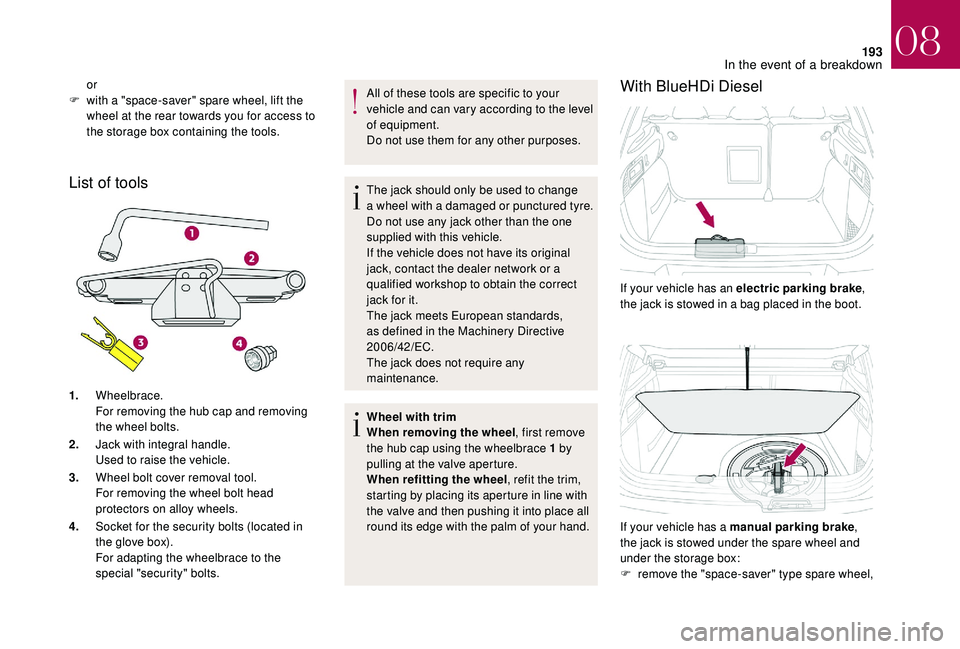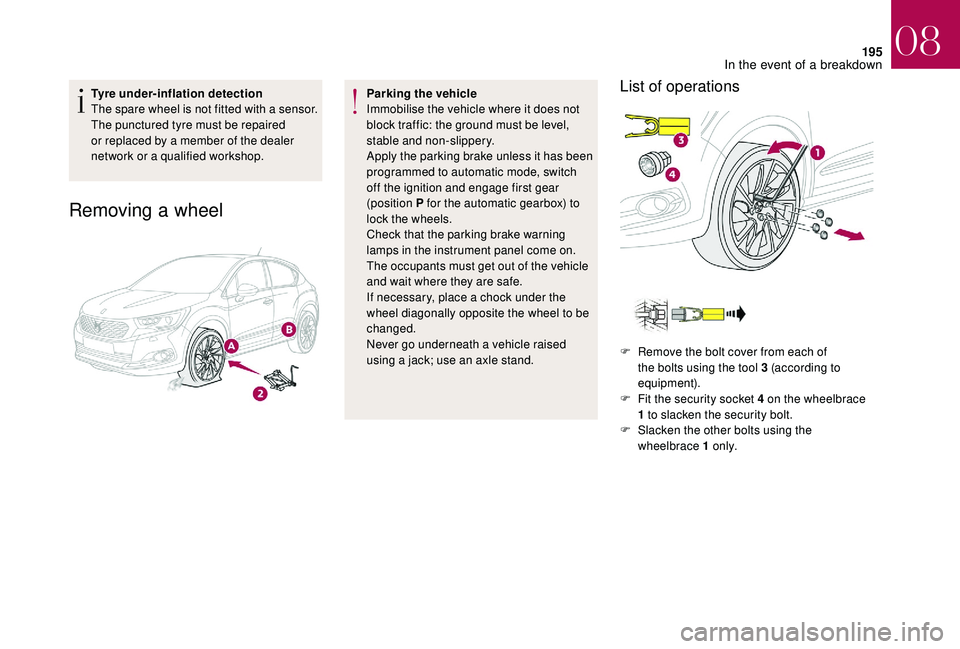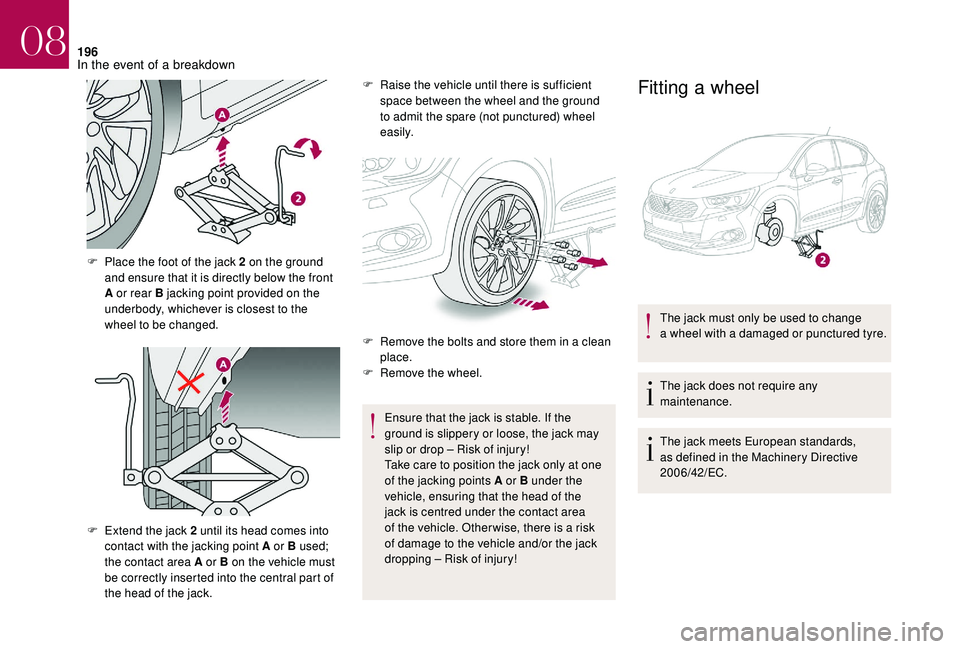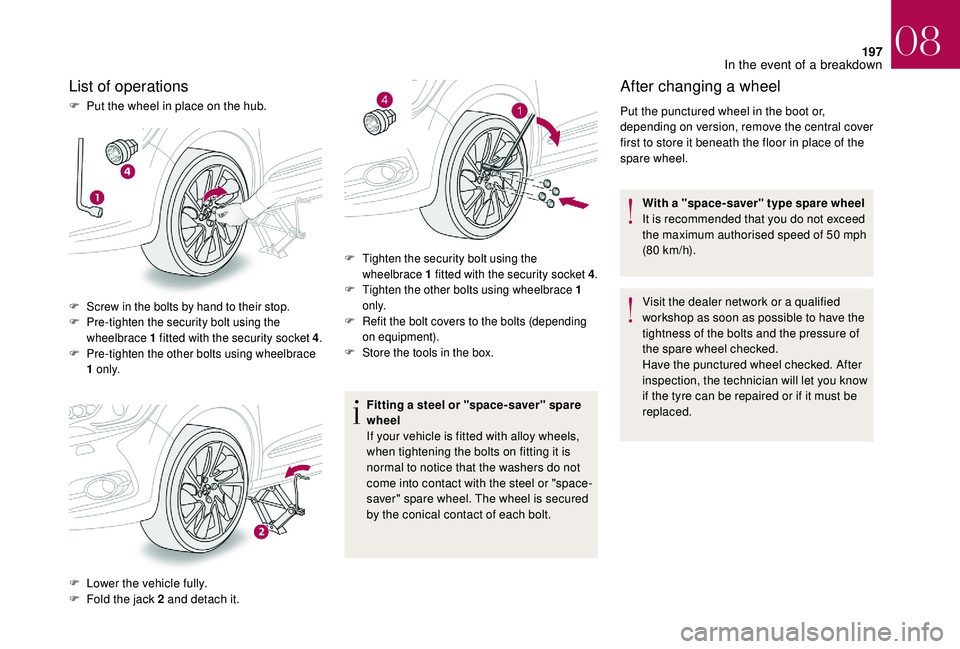wheel bolts CITROEN DS4 2018 Owners Manual
[x] Cancel search | Manufacturer: CITROEN, Model Year: 2018, Model line: DS4, Model: CITROEN DS4 2018Pages: 296, PDF Size: 9.91 MB
Page 195 of 296

193
List of tools
1.Wheelbrace.
For removing the hub cap and removing
the wheel bolts.
2. Jack with integral handle.
Used to raise the vehicle.
3. Wheel bolt cover removal tool.
For removing the wheel bolt head
protectors on alloy wheels.
4. Socket for the security bolts (located in
the glove box).
For adapting the wheelbrace to the
special "security" bolts. All of these tools are specific to your
vehicle and can vary according to the level
of equipment.
Do not use them for any other purposes.
The jack should only be used to change
a wheel with a damaged or punctured tyre.
Do not use any jack other than the one
supplied with this vehicle.
If the vehicle does not have its original
jack, contact the dealer network or a
qualified workshop to obtain the correct
jack for it.
The jack meets European standards,
as defined in the Machinery Directive
2006/42/EC.
The jack does not require any
maintenance.
Wheel with trim
When removing the wheel
, first remove
the hub cap using the wheelbrace 1 by
pulling at the valve aperture.
When refitting the wheel , refit the trim,
starting by placing its aperture in line with
the valve and then pushing it into place all
round its edge with the palm of your hand.
With BlueHDi Diesel
If your vehicle has an electric parking brake ,
the jack is stowed in a bag placed in the boot.
or
F
w
ith a "space-saver" spare wheel, lift the
wheel at the rear towards you for access to
the storage box containing the tools.
If your vehicle has a manual parking brake,
the jack is stowed under the spare wheel and
under the storage box:
F
r
emove the "space-saver" type spare wheel,
08
In the event of a breakdown
Page 197 of 296

195
Tyre under-inflation detection
The spare wheel is not fitted with a sensor.
The punctured tyre must be repaired
or replaced by a member of the dealer
network or a qualified workshop.
Removing a wheel
Parking the vehicle
Immobilise the vehicle where it does not
block traffic: the ground must be level,
stable and non-slippery.
Apply the parking brake unless it has been
programmed to automatic mode, switch
off the ignition and engage first gear
(position P for the automatic gearbox) to
lock the wheels.
Check that the parking brake warning
lamps in the instrument panel come on.
The occupants must get out of the vehicle
and wait where they are safe.
If necessary, place a chock under the
wheel diagonally opposite the wheel to be
changed.
Never go underneath a vehicle raised
using a jack; use an axle stand.List of operations
F Remove the bolt cover from each of the bolts using the tool 3 (according to
equipment).
F
F
it the security socket 4 on the wheelbrace
1 to slacken the security bolt.
F
S
lacken the other bolts using the
wheelbrace 1 o n l y.
08
In the event of a breakdown
Page 198 of 296

196
F Place the foot of the jack 2 on the ground and ensure that it is directly below the front
A or rear B jacking point provided on the
underbody, whichever is closest to the
wheel to be changed. F
Ra
ise the vehicle until there is sufficient
space between the wheel and the ground
to admit the spare (not punctured) wheel
easily.
F
R
emove the bolts and store them in a clean
place.
F
R
emove the wheel.
Ensure that the jack is stable. If the
ground is slippery or loose, the jack may
slip or drop – Risk of injury!
Take care to position the jack only at one
of the jacking points A or B under the
vehicle, ensuring that the head of the
jack is centred under the contact area
of the vehicle. Other wise, there is a risk
of damage to the vehicle and/or the jack
dropping – Risk of injury!
F
E
xtend the jack 2 until its head comes into
contact with the jacking point A or B used;
the contact area A or B on the vehicle must
be correctly inserted into the central part of
the head of the jack. The jack must only be used to change
a wheel with a damaged or punctured tyre.
The jack does not require any
maintenance.
The jack meets European standards,
as defined in the Machinery Directive
2006/42/EC.
Fitting a wheel
08
In the event of a breakdown
Page 199 of 296

197
F Screw in the bolts by hand to their stop.
F P re-tighten the security bolt using the
wheelbrace 1 fitted with the security socket 4 .
F
P
re-tighten the other bolts using wheelbrace
1 o n l y.
F Lower the vehicle fully.
F F old the jack 2 and detach it.
F Tighten the security bolt using the wheelbrace 1 fitted with the security socket 4 .
F
T
ighten the other bolts using wheelbrace 1
o n l y.
F
R
efit the bolt covers to the bolts (depending
on equipment).
F
S
tore the tools in the box.
Fitting a steel or "space-saver" spare
wheel
If your vehicle is fitted with alloy wheels,
when tightening the bolts on fitting it is
normal to notice that the washers do not
come into contact with the steel or "space-
saver" spare wheel. The wheel is secured
by the conical contact of each bolt.
After changing a wheel
Put the punctured wheel in the boot or,
depending on version, remove the central cover
first to store it beneath the floor in place of the
spare wheel.With a "space-saver" type spare wheel
It is recommended that you do not exceed
the maximum authorised speed of 50 mph
(80 km/h).
Visit the dealer network or a qualified
workshop as soon as possible to have the
tightness of the bolts and the pressure of
the spare wheel checked.
Have the punctured wheel checked. After
inspection, the technician will let you know
if the tyre can be repaired or if it must be
replaced.
List of operations
F Put the wheel in place on the hub.
08
In the event of a breakdown